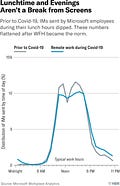HRHeadStart #18: Risks of Flexible Work; Smart Thinking; "Lunch" Problem
The Talent Agenda
Volatility has always been thought of as a bug. Now, it’s a feature. If our world was upended in 2020 and 2021, there are no signs that 2022 will bring any less volatility. New Covid variants, high inflation, all-time high resignation rates and widespread talent shortages will force leaders to make tough choices. Flexible working is also likely to be the norm and that will create new tensions.
Firstly, it is possible that the trend of flexible work will increase attrition over time. Employees who work remotely are likely to have weaker social or emotional connections with their co-workers. These weaker connections make it easier for employees to quit their job by reducing the social pressure that can encourage employees to stay longer.
Secondly, while flexible work is no longer a differentiator and now considered table stakes, there will be employee segments where this is not an option. This will raise questions about fairness and equity. Fairness and equity will have other dimensions too. How do we justify staggering pay premiums to hire new talent in a tight market? How (and if at all) should compensation change if an employee moves to a location with lower cost of living?
Finally, the impact of prolonged remote working on health and well-being needs to be considered. Long periods of sitting, staring at screens, mind-numbing calendar schedules, lack of social work outings etc. will all affect employees’ cognitive capacity, physical health and mental health.
We are living through the greatest workplace disruption in generations and there has never been a better time to be in HR to get a first-hand experience of navigating the turmoil.
Working Better
Our best bet for solving for some the complexities described above lies in the combination of brilliant technical solutions and deep thinking. The world lauds people who are "decisive" and make decisions fast. But the best thinkers are slow thinkers. While making or recommending a decision, they carefully peel the layers by asking "what happens next" a few times - what happens in 5 days, 5 weeks, 5 months and 5 years of making the decision. That reveals the true nature of the problem, the solution and the stakeholders who are affected by those decisions, thus creating a better path to making progress. Such questioning is a powerful way to stress-test the future of your decisions. Good thinking is expensive, but poor thinking costs a fortune.
P.S. It turns out that the article by Clayton Christensen on “How Will You Measure Your Life?” shared in the last newsletter was the all-time top clicked link on HRHeadStart. Hence, sharing it again for those who may not have checked it out.
A Productive Workout
An interesting analysis by Microsoft showed that the number of IMs sent by its employees increased as the day progressed, dipped during lunch hours, picked up again after lunch before crawling down as the day ended. During Covid, however, the dip during lunch hours was not as pronounced. Non-stop working became the norm.
As you mull over this problem, what are your ideas to influence this situation? What hard or soft levers you could use?
Tiny Thought
If you are super curious about something, it is likely you can be really good at it.
Community Resources
I wanted to share additional resources for HRHeadStart subscribers. My friend, Foo Chek Wee (Human Capital Head at The Straits Trading Company), has launched a great initiative to interview HR/business leaders every week to enable us to learn what others have already mastered. Check out Thrive in Asia to watch video interviews on a wide range of topics including organizational transformation, design thinking, working in startups etc. This is a passion-powered and free project for the development of the HR community, so make the most of it.



